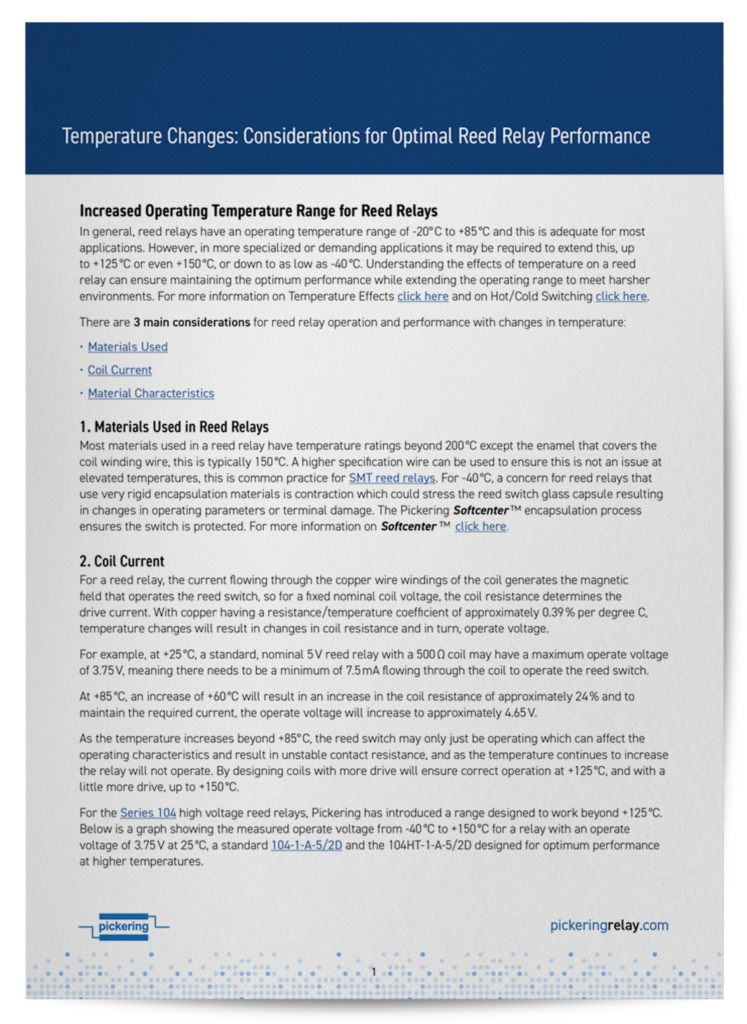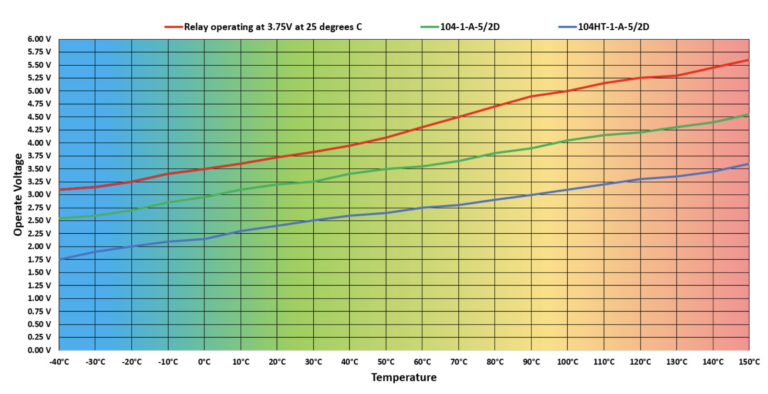Mastering Temperature Changes: Key Considerations for Optimal Reed Relay Operation and Performance
In general, reed relays have an operating temperature range of -20° C to +85°C and this is adequate for most applications. However, in more specialized or demanding applications it may be required to extend this, up to +125°C or even +150°C, or down to as low as -40°C. Understanding the effects of temperature on a reed relay can ensure maintaining the optimum performance while extending the operating range to meet harsher environments.
There are 3 main considerations for reed relay operation and performance with changes in temperature:

1. Materials Used in Reed Relays
Most materials used in a reed relay have temperature ratings beyond 200 °C except the enamel that covers the coil winding wire, this is typically 150 °C. A higher specification wire can be used to ensure this is not an issue at elevated temperatures, this is common practice for SMT reed relays. For -40 °C, a concern for reed relays that use very rigid encapsulation materials is contraction which could stress the reed switch glass capsule resulting in changes in operating parameters or terminal damage. The Pickering Softcenter™ encapsulation process ensures the switch is protected. For more information on Softcenter™ click here.
2. Coil Current
For a reed relay, the current flowing through the copper wire windings of the coil generates the magnetic field that operates the reed switch, so for a fixed nominal coil voltage, the coil resistance determines the drive current. With copper having a resistance/temperature coefficient of approximately 0.39 % per degree C, temperature changes will result in changes in coil resistance and in turn, operate voltage.
For example, at +25 °C, a standard, nominal 5 V reed relay with a 500 Ω coil may have a maximum operate voltage of 3.75 V, meaning there needs to be a minimum of 7.5 mA flowing through the coil to operate the reed switch.
At +85 °C, an increase of +60 °C will result in an increase in the coil resistance of approximately 24 % and to maintain the required current, the operate voltage will increase to approximately 4.65 V.
As the temperature increases beyond +85° C, the reed switch may only just be operating which can affect the operating characteristics and result in unstable contact resistance, and as the temperature continues to increase the relay will not operate. By designing coils with more drive will ensure correct operation at +125 °C, and with a little more drive, up to +150 °C.
For the Series 104 high voltage reed relays, Pickering has introduced a range designed to work beyond +125 °C. Below is a graph showing the measured operate voltage from -40 °C to +150 °C for a relay with an operate voltage of 3.75 V at 25 °C, a standard 104-1-A-5/2D and the 104HT-1-A-5/2D designed for optimum performance at higher temperatures.

Other factors to be considered are voltage drops across the relay driver resulting in less than the nominal voltage being applied to the coil, and for reed relays not manufactured by Pickering, magnetic interaction with adjacent relays can increase the operate voltage by up to 40 % compared to the relay alone. For more information on Magnetic Interaction click here.
A reduction in drive reduces the overdrive, this is the level of magnetic field above the just operate point, and it affects a range of parameters. With adequate overdrive, this increased magnetic field pushes the contact surfaces together with more force giving lower, stable contact resistances and significantly improving life expectancy. It also brings the contact blades together faster ensuring better operate times.
In reality, Pickering designs their reed relays to operate below the 3.75 V limit, for the 104-1-A-5/2D this is typically 2.75 V to 3.25 V, and with the 104HT-1-A-5/2D it is designed to be similar at +125 °C.
3. Material Characteristics
As temperature increases, insulation resistance tends to decrease in most materials. However, it’s important to consider a balance between the desired mechanical properties, adhesion, pin retention, and the choice of encapsulation materials.
For the Series 104 range, this can be more important as the insulation resistance determines the leakage current and at higher voltages, this could be more significant than for low voltage reed relays. The graph below shows the changes in insulation resistance with temperature for a Series 104 1 form A reed relay. Although still much better than other switching technologies, this can be an important consideration.
Where higher values are required, other materials may provide a solution but there could be other mechanical considerations with less rigid materials being used. For specialised requirements, contact Pickering who will be able to discuss the available options.

Another factor that may need to be considered is the change in contact resistance with temperature. All metals have a temperature coefficient of resistance and the switch path through the reed relay will be no different, as will circuit board tracks, connectors etc. It can be dependent on the reed relay type as path lengths and material cross sectional area vary, but a 3 % to 5 % change per 10 °C change is typical.
This is something to be aware of when applications rely on consistent contact resistances, and in high continuous or pulsed carry current applications where the power dissipated across the switch can increase its temperature. If this is a concern, please contact techsales@pickeringrelay.com for expert advice.
The Series 104HT range from Pickering is specifically designed to provide reliable performance and long-lasting durability in temperatures ranging from -40 °C to +125 °C, and the same principles can be applied to the majority of our reed relay ranges. If you need more information, don’t hesitate to contact us. We’re here to help.






